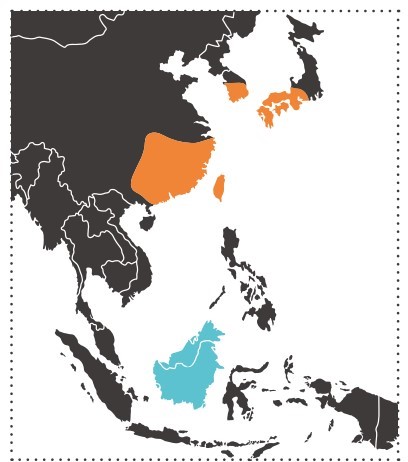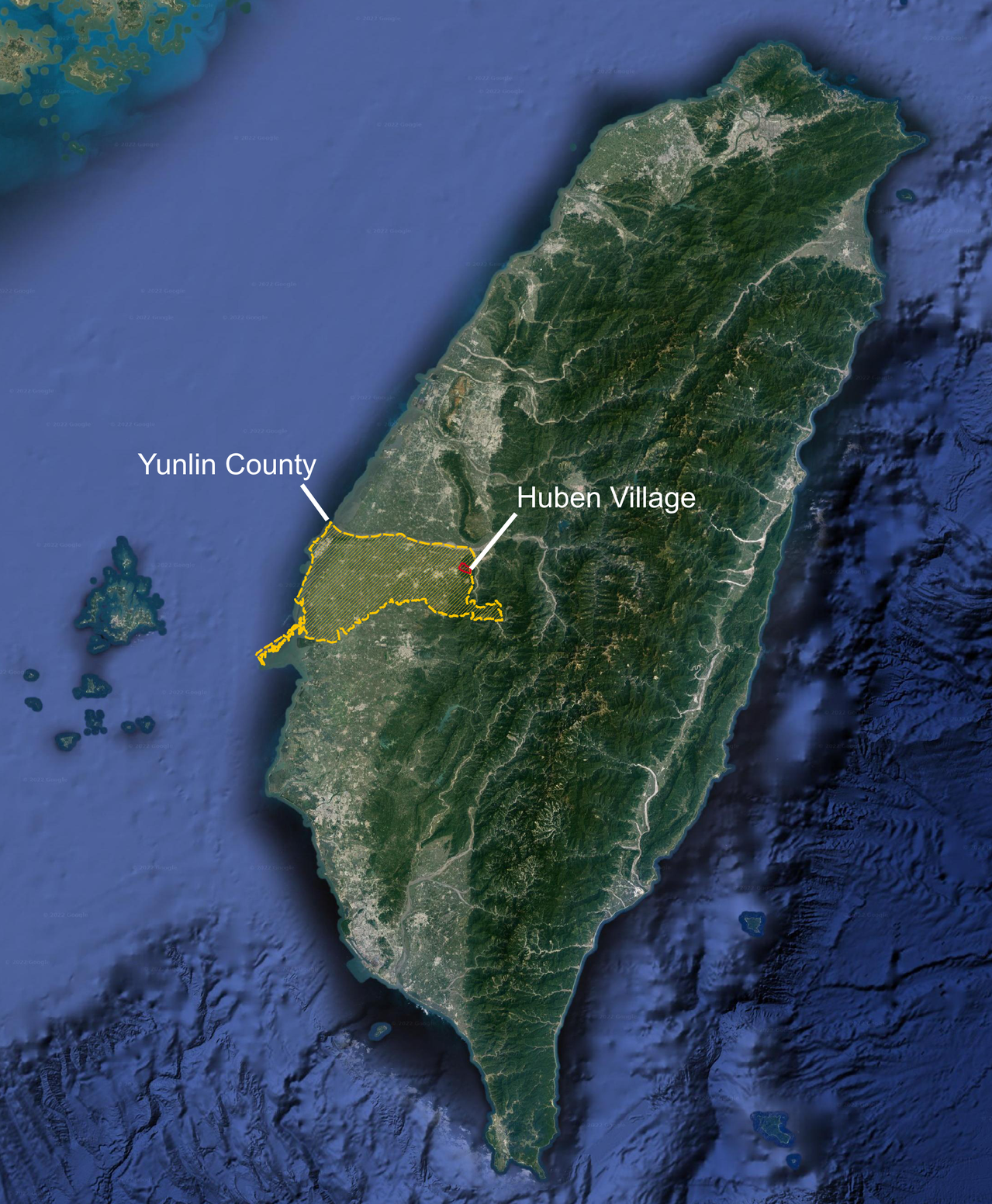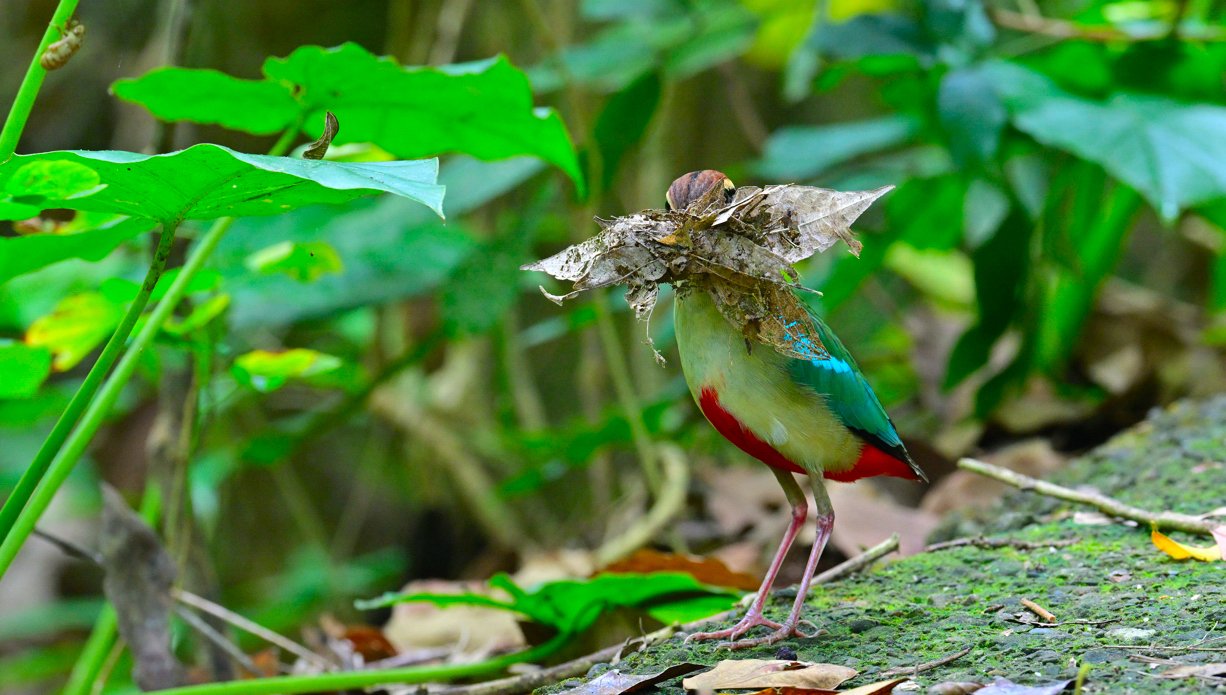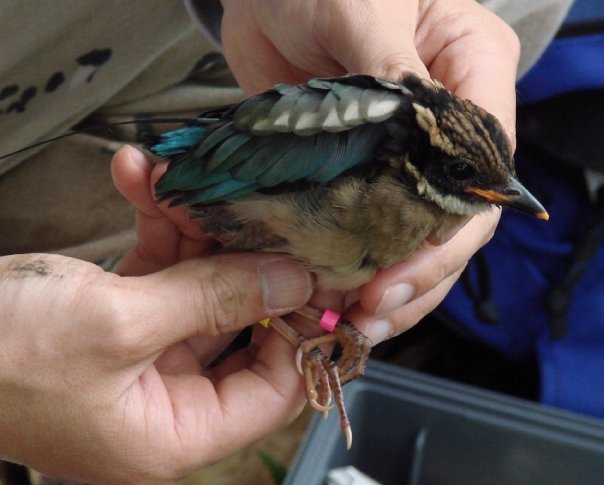Eight Colors, One Future: Fairy Pitta Conservation in Taiwan and Efforts for the Future -Part 2
By Scott Pursner, Taiwan Wild Bird Federation Director of International Affairs
Part Two of a Two Part Series

Fairy Pitta. (Credit: Philip Kuo)
The Fairy Pitta (Pitta nympha) is a long-distance migratory land bird restricted to the East Asian-Australasian Flyway. Known in Mandarin as the "eight-colored bird" (八色鳥), its extensive breeding range includes the Korean Peninsula, China, Japan, and Taiwan. Taiwan, however, is where much of the research on the species over the last 20 years has been conducted. This passerine also holds special significance in Taiwan among those involved in the country's environmental movement as it played an outsized role in Taiwan's modern conservation history. Yet for such a brightly colored bird, it still keeps its secrets well hidden. Even now, there is much that is not known about the species, which is considered "vulnerable" by the IUCN.
Where Have All the Pitta Gone?
According to Taiwan Endemic Species Research Institute researcher and Fairy Pitta expert Scott Ruey Shing Lin, the Fairy Pitta population in Taiwan decreased during 2001 to 2010. But numbers have since stabilized, and over the last 10 years, there has been much more research done locally and internationally about this elusive creature. Lin keeps in frequent communication with researchers in Korea and Japan who also work on the Fairy Pitta. According to him, "In Japan, there is a steady amount of research taking place. There are now more researchers working on this topic in Korea and in China too. So, you could say that now there is much more information out there on the Fairy Pitta."
Dr. Scott Lin (center right) participates in a Fairy Pitta meeting in Japan, 2016. (Credit: Scott Lin)
Lin explained, "In Taiwan, the most important thing we need to do now is protect the forest in the lowland areas. But not just for the Fairy Pitta. Even if we did that, we could not make it come back due to complicated population fluctuations. But it [conservation] is useful for other protecting ecosystems as a whole. Many species rely on these habitats."
He continued, "After studying it for a long time, I found that generally in Taiwan, the forest protection in the lowlands is quite good compared to other parts of the world. In Taiwan now, habitat loss for forests is very low. In Taiwan we just keep the forests and there is nothing more we can do for it [the Fairy Pitta]."
Fairy Pitta Habitat in Huben Village, Yunlin County, Taiwan. (Credit: Scott Lin)
Lin feels that the current threats to the Fairy Pitta come from habitat loss in their major wintering area and climate change, a point which he and a team of Taiwanese researchers brought home in a paper published earlier this year (1). He says, "One of the major gaps is understanding the migration links between the breeding and wintering sites. There is a major document concluding that they winter in Borneo. That is definitely an important wintering site, but we have very little information on the wintering sites, only a few records. And Borneo is huge, with most areas difficult to access."
Though Lin tried to further investigate the situation in Borneo with researchers in Sarawak when he visited in 2008, there has been little progress.
Conservationist Yong Ding-Li, who is the flyways coordinator at the BirdLife International's office in Asia, echoes Lin's sentiments about the need for more collaboration among organizations along the Fairy Pitta's range. Yong first visited Taiwan in 2009 with a goal of seeing the jewel of the forest after having read Lin's reports. Now, after years of following research and studies, he has identified several challenges surrounding Fairy Pitta conservation, particularly in Southeast Asia. The first is prioritization. As he put it, "Migratory species conservation remains difficult in Southeast Asia, as researchers and conservationists are already working on a number of issues and threatened species, such as hornbills."

Known Distribution Range of Fairy Pitta accoring to State of Taiwan's Birds 2020 Report: orange = breeding, blue = wintering. (Credit: TWBF/TESRI/SOTBP)
Yet according to Yong, in recent years more pitta sightings have been recorded. He mentioned that through conversations with colleagues in Vietnam, he discovered two recent records on Fairy Pittas, one of which was confirmed to be taken in December. Also, in April 2022, for the first time ever, one showed up in a park in Ho Chi Minh City (2). A week later, in a first for Cambodia, one was spotted in a park in the capital of Phnom Penh (3). Just a week later, a Fairy Pitta was spotted in Bangkok (4). According to Yong, Thailand see some Fairy Pittas passing through every year. He mentioned that on the small island of Koh Man Nai, leading expert on migratory birds and conservationist Philip Round has been doing banding there each spring for over 10 years. Over a two-week period, several Fairy Pittas are banded. Yong and Round have a hypothesis, "The Fairy Pittas are coming from Malaysia. Because if you draw a straight line down from this island, it's the Malay Peninsula. So, we believe the pittas are coming from the Malay Peninsula where they possibly winter. But we don't have any evidence yet."
However, Yong notes there are not many birdwatchers in the eastern parts of peninsular Malaysia, and the ones who are there often frequent the same areas. "The bottom line is that just because there is no record of a bird for a location, it doesn't necessarily mean it isn't there. It could just be that no one looked yet. So that's what we are thinking is happening in Southeast Asia."
Aside from Cambodia, Vietnam, and Thailand, Yong said that some recent records have also come from Indonesia, with a recent paper highlighting sightings on the Riau Islands and Java (5). Borneo is still considered to be the main wintering ground by many experts, but surveying the island for wintering pittas remains difficult. Yong explained that birders there "don't usually go inland for birdwatching in December because it's the rainy season in the region. It will be raining on most of the island and some areas will be flooded. Others will be inaccessible because the ground becomes swampy."
Borneo is also prohibitively vast in size. He explained, "Borneo is so large, you could fit all of Japan, all of Taiwan, and all of the Korean peninsula in it, and you would still have some area. That's how big the island is … As it is so big, and with how dense the Bornean rainforests are, not to mention that they do not call in the non-breeding season, trying to find them would be the equivalent of finding eight-colored needles in haystacks."
As for the rest of Southeast Asia, there has only been one record in the Philippines (6).
One key question is just how many Fairy Pitta there are in total. According to BirdLife International's Data Zone, there are an estimated 1,500 to 7,500 in the current global population (7). Yet after doing his island-wide surveys, Lin thinks the number may be different. "I would say that in Huben Village in Yunlin County, from 2001 to 2005, the population was about 40 to 70 in that small village of only 400 hectares. So, if the density was that high, you could understand that, as there are many similar habitats throughout all of Taiwan, it is very possible there could've been 20,000 to 30,000 throughout Taiwan then."

Map of Taiwan highlighting Yunlin County and Huben Village. (Credit: TWBF)
Currently, modelling done based on survey results make Lin feel as though there could be between 6,000 to 12,000 breeding Fairy Pitta in Taiwan. He explained that population trends show numbers going down in north and west-central Taiwan, but remained stable or even increased in the south and east. "In Hualian and Taitung [eastern Taiwan], I can stand in one spot and hear four to five nearby. It's really similar to my experience in Huben in the early 2000s."

Fairy Pitta with nesting materials. (Credit: Philip Kuo)
This experience was shared by Chiu Chen-ching, a researcher for the Taiwan Wild Bird Federation who took part in the 2021 Fairy Pitta Survey. "You're really surprised because you don't expect it, but with playback, they [Fairy Pitta] call immediately back. They really respond within about one minute. In some spots, they were already singing when I arrived."
Yet even with more detailed breeding site information across Taiwan, Japan, and Korea, there is still one breeding area where there is a data gap – China. Yong explained that, while there has been limited research done there so far, Chinese researchers published a paper in 2017 about Fairy Pitta and Blue-rumped Pitta breeding in limestone forests in southern China's Guangxi Province, near the Vietnam border (8). Yong himself has had experiences seeing Fairy Pitta in Guangdong Province in a forested area he said was environmentally comparable to that of Huben. He also learned that a Chinese birdwatcher regularly sees it at Dongzhai Nature Reserve in Henan. "I suspect that the northern limit of the mainland Chinese breeding population is probably around Jiangsu Province. Somewhere between Jiangsu and Hubei Province." Yong continued, "The breeding region of Fairy Pitta based on these bits of information that I have gathered is between Guangxi and somewhere around the middle of Jiangsu. So it is actually quite a large region."
Nesting Fairy Pitta in area around Huben Village. (Credit: Scott Lin)
Yong noted that it's possible there could be two different populations, one that migrates between China and Southeast Asia, and another which breeds in Korea, Japan, and Taiwan and winters in Borneo. But more research, international collaboration, and sharing is necessary to prove this theory, and more broadly understand the migrations of different Fairy Pitta populations.
Some have suggested that radio transmitters could be used to monitor the migration patterns of Fairy Pittas, an approach that Lin had previously attempted. "I tried [to use radio tracking] 10 years ago, but it was difficult because of the weight of the satellite tag at the time. The other reason is that the Fairy Pitta is a forest bird, so the battery is another issue." He mentioned that another option was the use of GPS tags, but "you'd need to recover the bird and that would not be easy with a species like the Fairy Pitta." He explained, "First you'd need to capture and put the tags on. Then they'd need to come back to the same site, and you'd need to capture them again and make sure the tags are ok." He attempted doing tracking twice but was ultimately unsuccessful.

Scott Lin attempted to use a transmitter to track a Fairy Pitta, yet after 3 weeks the signal was lost, 2007. (Credit: Mark Wilkie)
According to both Lin and Yong, what's needed now more than ever is closer cooperation amongst range countries. As Lin put it, "Until now, we still do not understand much about habitat loss and changes in Borneo and where the important stopover sites and wintering sites for Fairy Pitta are. The main thing is to try and make the linkages."
Unfortunately, there are currently no international conservation plans for the Fairy Pitta.
In Taiwan, the fight to save the Fairy Pitta did have some major impacts. As Lin put it, "For Huben, I would say they used the Fairy Pitta as a kind of weapon, and it was quite successful for the village. Up to now they are still safe from gravel extraction."
And though the fight to stop the Hushan Dam didn't end as many hoped, the movement had effects which proved far-reaching. In the words of Mark Wilkie who was heavily involved in the battle against the Hushan Dam, "As a spinoff from that, the Dacheng Wetlands where they had planned to put the steelworks and petrochemical plant were saved. That fight grew out of the Hushan Dam protests. When they announced the scrapping of those plans, it was 2011, and what a day that was. That in a big way involved the [Taiwanese Humpback] dolphins, but Hushan Dam always came up in that. There also haven't been any major dam projects since the Hushan Dam."
Still, after all these years, the Fairy Pittas hold onto their secrets, and local researchers and conservationists continue to work hard to understand and protect them.
As a closing thought, Lin noted that, "For me, the most important thing is to try and protect the remaining good habitat in their wintering sites and restore them if possible. The Fairy Pitta is just one species using the habitat. Even though I've done Fairy Pitta research for a long time, I still feel that using what limited resources are available to protect the habitat is the most important thing. There are too many species to protect, so to say that one is more important than the other isn't right. The ecosystem itself needs to be protected."
Part One in the series can be found here
*Cover Photo: Fairy Pitta (Credit: Philip Kuo)
References:
(1) Ko JCJ, AY Chang, RS Lin, PF L. 2022. Effects of breeding habitat loss on a threatened East Asia migratory forest bird. Conservation Science and Practice, 4, e12772.
https://conbio.onlinelibrary.wiley.com/doi/pdf/10.1111/csp2.12772
(2) Tho H. 2022. Khi con chim Pitta về đậu vườn tao đàn. TUỔI TRẺ CUỐI TUẦN. Retrieved 6/10/2022.
https://cuoituan.tuoitre.vn/khi-con-chim-pitta-ve-dau-vuon-tao-dan-16431...
(3) B/W Asia. 2022. "សត្វស្លាបកម្រ ប៉ាក់ខ្ទៀវជញ្ជើមវែង - Fairy pitta bird at Cambodia". Youtube. Retrieved 6/10/2022. https://www.youtube.com/watch?v=6RCiwUOh4-Q
(4) Hambly S. 2022. Fairy Pitta in Bangkok. Wordpress. Retrieved 6/10/2022.
https://largeblueflycatcher.com/2022/05/07/fairy-pitta-in-bangkok/
(5) Aminuddin SF, AKS Putera, N Zackeisha, TN Sulaeman, A Nasution. 2021. The status of Fairy Pitta in Indonesia with new records from Java and Riau Islands. KUKILA, 23(1), 32-36.
http://kukila.org/index.php/KKL/article/view/605
(6) Jensen AE, TH Fisher, RO Hutchinson. 2015. Notable new bird records from the Philippines. Forktail, 31 24-36.
https://static1.squarespace.com/static/5c1a9e03f407b482a158da87/t/5d39d6...
(7) BirdLife International. 2022 .Species factsheet: Pitta nympha. Retrieved 6/10/2022.
http://datazone.birdlife.org/species/factsheet/22698684
(8) Jiang A, G Yang, E Pagani-Núñez, D Jiang. 2017. Ecology of two Pittas (Pitta soror and Pitta nympha) in limestone forests of South China. Journal of Natural History, 51, 31-32.
https://www.tandfonline.com/doi/abs/10.1080/00222933.2017.1355490?journa...
